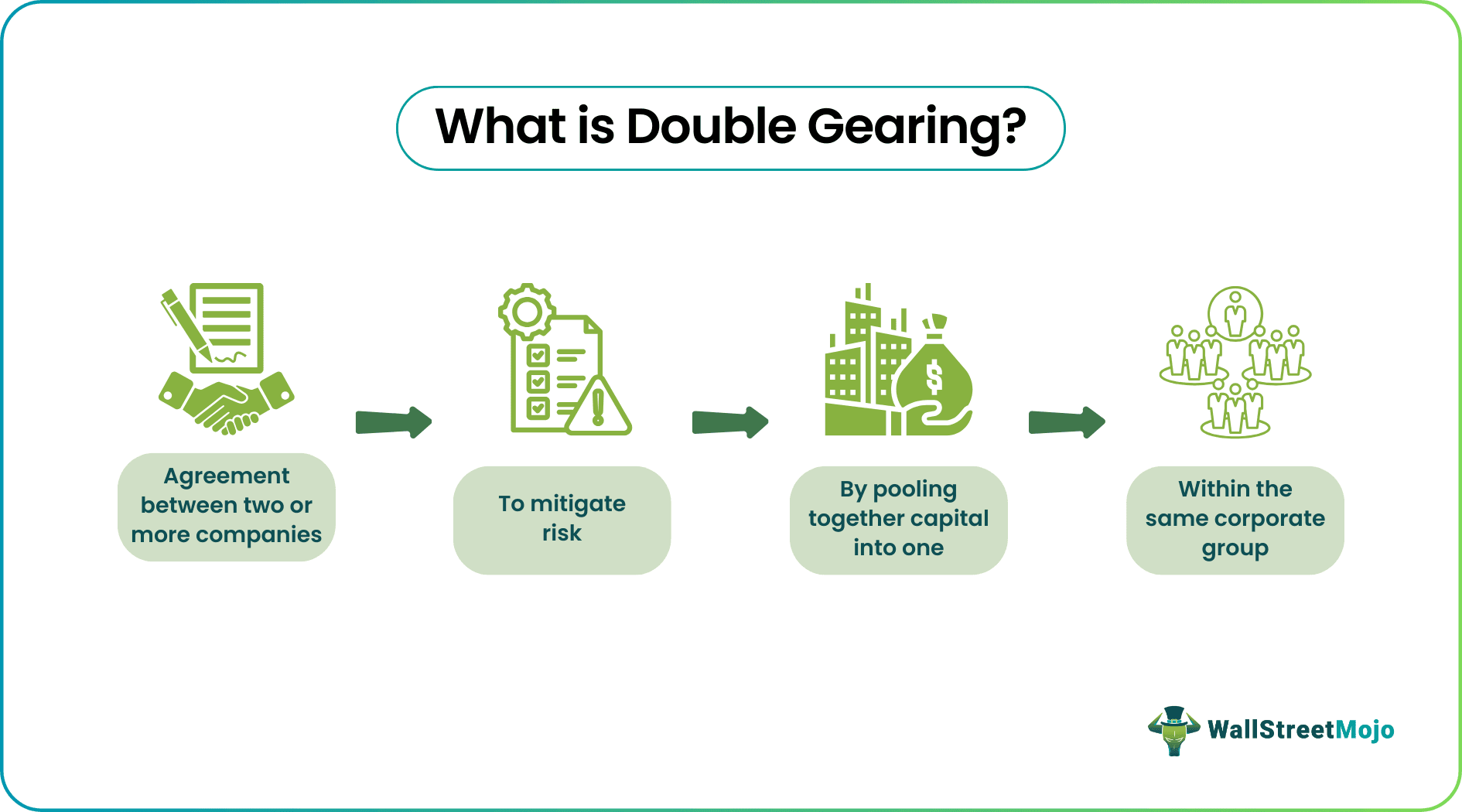Table Of Contents
Double Gearing Meaning
Double gearing, also known as double leverage or nested gearing, is a financial strategy corporations use to manage risk and optimize their capital structure. It involves multiple layers of debt or financial leverage within a corporate group, typically consisting of a parent company and its subsidiaries.

It provides companies with financial flexibility and risk management advantages while influencing how their financial health appears to external stakeholders. Furthermore, the extent of tax advantages derived from double gearing can vary depending on specific structural arrangements and the regulatory landscape in different jurisdictions.
Key Takeaways
- Double gearing is a financial strategy involving multiple layers of leveraging or borrowing within a corporate structure.
- This strategy includes a parent company and its subsidiaries, with each level of the structure using debt or leverage in their financial operations.
- The primary goal of double gearing finance is often to optimize the capital structure of the corporate group, potentially gaining tax advantages, reducing the cost of capital, or achieving other financial objectives.
Double Gearing Strategy Explained
Double gearing, a prevalent financial strategy in the corporate landscape, primarily aims to mitigate risk by consolidating resources, particularly capital. This practice typically entails one participating company investing funds into another, often within the same industry or sector, signifying a strategic partnership to bolster their financial positions. For instance, a bank might extend a loan to an insurance company, and the insurance company might, in turn, allocate borrowed funds to invest in the bank.
One of the prominent outcomes is its potential to obscure the true extent of risk exposure for each company. This complexity arises from multiple entities within the agreement potentially claiming the same assets as part of their capital, thereby creating a convoluted network of intertwined financial relationships. While resource-sharing may mitigate risk, it doesn't necessarily provide an accurate portrayal of the individual risk profiles of each company, often creating a situation where the apparent risk reduction is more illusory than substantive.
It often results in an inflation of capital within a corporate conglomerate. Conglomerates comprise various companies under shared ownership or control, each operating independently. Parent companies typically establish these subsidiaries to segregate business activities, enabling them to file consolidated tax reports. This approach offers tax advantages by offsetting gains and losses between different subsidiaries, potentially reducing taxable revenues.
Nevertheless, it can lead to leveraging and overleveraging within the corporate structure. Leveraging involves using borrowed funds for investments or operations. In some cases, intermediary entities may be established solely to manage investments in lower-tier subsidiaries, often needing more substantial assets aside from these investments. This intricate arrangement complicates the assessment of the entire corporate group's financial health, involving multiple tiers of leverage and asset allocation.
Examples
Let us look at some examples to understand the concept better.
Example #1
Suppose a multinational conglomerate in the technology sector strategically utilizes this financial practice to optimize its capital structure and manage risk. The conglomerate's parent company, TechCorp, has several subsidiary companies specializing in various technology subsectors. One such subsidiary, CloudTech, decided to secure a significant loan from TechCorp to fund its expansion in cloud computing services.
Simultaneously, TechCorp acquires another subsidiary, DataSys, specializing in data analytics, by investing a substantial portion of its capital into DataSys. This arrangement allows CloudTech to access the capital it needs to multiply while providing TechCorp with a diversified portfolio of technology companies. However, the complexity of this structure may obscure the conglomerate's accurate risk exposure and financial health, which must be carefully managed and transparently reported to stakeholders.
Example #2
Imagine a conglomerate, EnergyCorp, operating in the energy sector. One of its subsidiaries, SolarPowerCo, specializes in renewable energy projects, while another, GasTech, focuses on natural gas exploration.
- SolarPowerCo's Loan from EnergyCorp: SolarPowerCo seeks to expand its solar energy projects and receives a loan of $20 million from EnergyCorp with an interest rate of 4% per annum.
- GasTech's Investment by EnergyCorp: EnergyCorp invests $15 million directly into GasTech to support its natural gas exploration endeavors.
In this scenario:
- SolarPowerCo benefits from the $20 million loan to expand its renewable energy projects.
- GasTech receives a direct investment of $15 million from EnergyCorp to boost its natural gas exploration efforts.
This double gearing arrangement allows both subsidiaries to access the capital they need for growth while maintaining a complex financial structure that requires careful management and reporting.
Risks
There are significant risks associated with this strategy. Let us elaborate on these risks:
- High-risk-high-reward strategy: Companies or investors aim to amplify their potential returns by taking on additional debt or leveraging assets. However, this magnification works both ways – while it can lead to substantial gains, it also exposes them to more significant losses if investments don't perform as expected.
- Potential for severe losses: The increased leverage in double gearing means that the losses can be substantial if investments underperform or fail to generate the anticipated returns. The borrowed funds must still be repaid, including any associated interest or obligations. It can strain a company's finances or an investor's resources, potentially leading to financial distress or even insolvency.
- Debt overburden: It essentially involves borrowing to make purchases that can be used as collateral for further borrowing. While this can create opportunities for higher returns, it also poses the risk of accumulating too much debt. If the borrower cannot manage the debt effectively or if market conditions deteriorate, they can become overburdened by their financial obligations, leading to financial instability.
- Need for experienced management: Given its complexities and risks, this strategy is best suited for professional investors or companies with a strong financial management team. Novice investors or companies without the expertise to navigate the intricacies of leveraged finance may find themselves in challenging situations if their investments do not perform as expected.
